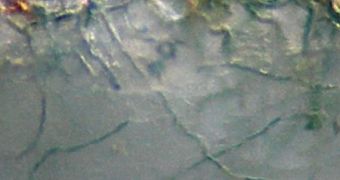For many years, researchers have been puzzled at how certain microorganisms are apparently capable of passing through carbonate-based substrates such as coral skeletons, limestone, mussel shells and sand grains. A new investigation finally sheds some light on this long-standing mystery.
Arizona State University (ASU) geo-microbiologists say that endolithic cyanobacteria – which are also photosynthetic microorganisms – can bore their way through carbonate substrates via the use of a calcium-driven pump, similar to the ones in our muscles.
This pump, which is a very tiny molecular structure, is “at the heart of an erosive force of global proportions,” explains Ferran Garcia-Piche, an ASU professor and the lead investigator on the study.
He presents his new discoveries in a paper called “Microbial excavation of solid carbonates powered by P-type ATPase-mediate transcellular Ca 2+ transport,” which appears in the November 29 issue of the esteemed journal Proceedings of the National Academy of Sciences (PNAS).
The father of American naturalists, expert Louis Agassiz, discovered more than a century ago that carbonate-based coral reefs can be subject to dissolution, but the phenomena underlying this transformation have not been studies in great detail since.
Further amplifying the mystery was a paradox - as a general rule, cyanobacteria tend to precipitate new carbonates, and not dissolve old one. If so, then why were corals dissolved?
Unlike normal cyanobacteria, which tend to raise the pH level of the waters they live in, boring cyanobacteria actually lower it, because they conduct photosynthesis at the same time that they dissolve carbonate structures. This results in more acidic waters, of lower pH.
Analyses conducted in the lab on filamentous, branching cyanobacteria called Mastigocoleus testarum revealed the physiological mechanisms at play when the organism invades calcite chips.
A groundbreaking finding came when the group realized that the bacteria were in fact taking calcium directly into their cells, through the tips of their boring filaments.
At the point of contact, the dissolution of the calcium-containing carbonate substrate was inevitable, the researchers say. The dissolution was however not generalized to surrounding areas.
“While it is hard to quantify the losses to the shellfish industry, the impact of endolithic bacteria has been described as a plague by Canadian fisheries,” Garcia-Pichel explains.
“We have identified compounds that abolish the boring activity by inhibiting the enzymatic calcium pumps involved in the process, which may be implemented eventually to protect targets, either by direct application or through genetic engineering of the mussels,” he concludes.

 14 DAY TRIAL //
14 DAY TRIAL //